More than a dozen times each year, we experience a strong pulse of "shooting stars" from an annual meteor shower. Sky & Telescope predicts that the two best meteor showers in 2018 will be the Perseids in mid-August and the Geminids in mid-December.
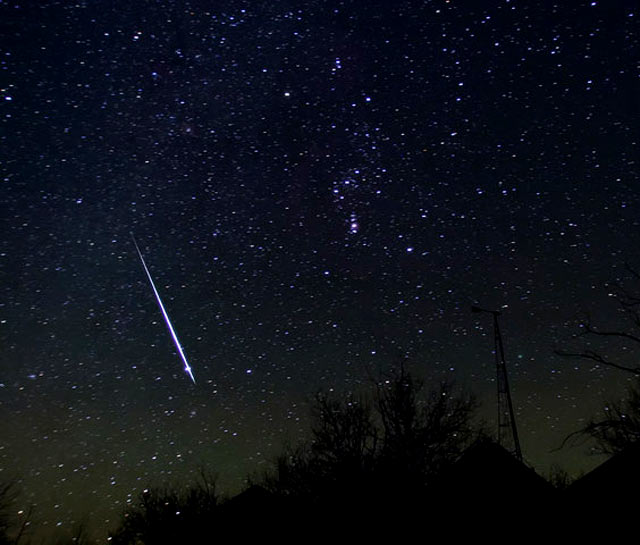
Imagine lying on a soft patch of grass and admiring the starry night sky overhead. Suddenly, you spot a bright streak that comes and goes literally in a flash. You've just seen a "shooting star," and it's time to make a wish — maybe for another one that's even brighter!
There's a chance that your wish will come true, because if you're looking up from a dark location, far from city lights, you'll see brief streaks from meteors a few times every hour. They can catch your eye just at the limit of visibility or be dramatically bright fireballs that appear brighter than Venus and light up the nightscape around you. The rarest of these, called a bolide, shatters into pieces during its rapid descent.
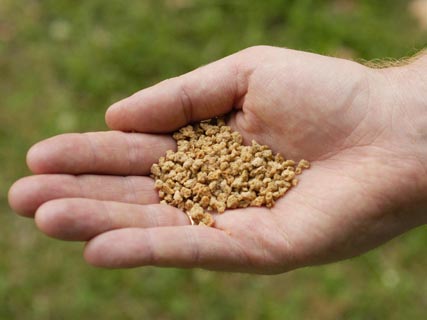
J. Kelly Beatty
Derived from the Greek word meteoros (meaning "high in the air"), meteors are bits of interplanetary debris that slam into Earth's upper atmosphere at speeds of 30 to 70 km (20 to 45 miles) per second! And although some meteors look bright enough that it seems you can almost touch them, actually they occur very high up, at altitudes of 80 to 120 km (50 to 75 miles).
Because they're arriving so fast, it doesn't take a very large particle to make a dramatic flash. Typically they're no bigger than big sand grains, and something the size of a pea can create a meteor that's dramatically bright. Those high velocities give each particle a lot of kinetic energy, which converts to heat due to friction in the upper atmosphere.
Many people think a meteor occurs because the particle is "burning up." But actually friction flash-heats air molecules along the particle's path to thousands of degrees. The air molecules cool down in just a split second, giving off light as they do so.
What is a Meteor Shower?
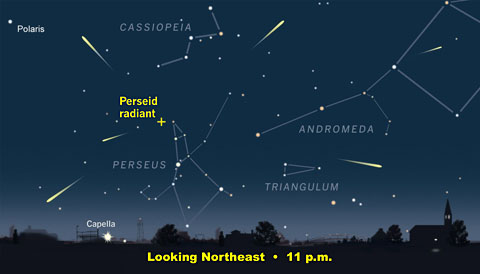
Sky & Telescope diagram
Meteors can occur at any time on any night and appear in any part of the sky. On a dark, moonless night you might see a half dozen of these sporadic (random) meteors per hour. However, whenever Earth encounters a stream of gritty debris left in space by a passing comet, the result is a meteor shower.
You'll notice the difference if you watch the sky for a half hour or so during one of these events: not only do the number of meteors you'll see go up, but also the meteors seem to fly away from a common point in the sky called the radiant.
This is a trick of perspective, because all these particles are traveling in parallel — part of a vast but sparse "river of rubble" that's spread all around the comet's orbit. To get a better sense of this, check out the interactive animation below, which is part of a set created by Ian Webster. It shows particles along the orbit of Comet 109P/Swift-Tuttle, which is the comet responsible for the Perseid meteor shower. (Have some fun with it: click and drag to get different perspectives):
A shower gets its name not from its parent object but from the constellation where this radiant lies — for example, August's well-known Perseid shower has its radiant in Perseus, December's Geminids appear to radiate from Gemini, and so forth. One notable exception to this rule is the Quadrantid shower, named for the now-defunct constellation Quadrans Muralis. Its radiant lies in the constellation Boötes. In any case, the higher a shower’s radiant, the more meteors it produces all over the sky.
The descriptions and table below highlight the year's best and most dependable displays, but the International Astronomical Union now recognizes more than 100 well-defined meteor showers and hundreds of other candidates that haven't been confirmed. Most of these are so weak that it takes a trained observer to spot them.
Meteor showers usually peak during the predawn hours on the dates listed below, though they're often active a few nights before and after the peak date. Note that the rates listed are for ideal conditions: very dark skies free of moonlight or light pollution, with the radiant nearly overhead. Most likely you'll see somewhat lower rates than those listed. Following the table are specific predictions for each shower's prospects during 2018.
Dynamicists have gotten rather good at predicting when a particular shower might display an extra burst of activity. Usually these are from concentrated "ribbons" of particles that might have been ejected by the parent comet decades or even centuries ago. However, no such outbursts have been predicted for any of the known meteor showers in 2018. It's shaping up to be a relatively normal year.
The editor of Sky & Telescope have assembled a complete guide to meteor observing, with resources for beginners and experienced amateurs alike. Our FREE Shooting Stars eBook covers the history, art, and science of meteor showers; just enter your email address below to access this download.
[form id="246617506"]
| Major Meteor Showers in 2018 | ||||
| Shower | Radiant and direction | Morning of maximum | Best hourly rate | Parent |
| Quadrantid* | Draco (NE) | Jan. 4 | 60-100 | 2003 EH1 |
| Lyrid | Lyra (E) | April 22 | 10-20 | Thatcher (1861 I) |
| Eta Aquariid* | Aquarius (E) | May 6 | 20-60 | 1P/Halley |
| Delta Aquariid* | Aquarius (S) | July 29 | 20 | 96P/Machholz |
| Perseid | Perseus (NE) | Aug. 13 | 90 | 109P/Swift-Tuttle |
| Orionid* | Orion (SE) | Oct. 21 | 10-20 | 1P/Halley |
| Southern Taurid | Taurus (S) | Nov. 5 | 10-20 | 2P/Encke |
| Leonid* | Leo (E) | Nov. 18 | 10-20 | 55P/Tempel-Tuttle |
| Geminid | Gemini (S) | Dec. 14 | 100-120 | 3200 Phaethon |
| Ursid* | Ursa Minor (N) | Dec. 22 | 10 | 8P/Tuttle |
* Strong moonlight will interfere with these showers.
Must-See Meteor Showers in 2018
Here are highlights of the major meteor showers for 2018. For the best possible viewing experience, find a dark location, make yourself comfortable in a reclining chair, and wear plenty of warm clothing (as appropriate). And for more information on watching and studying meteors, see our article on meteor basics and the other articles in the Meteor section of our website.
January 4: The Quadrantids
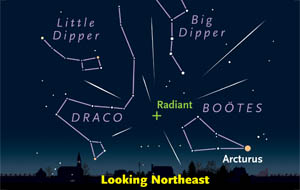
Sky & Telescope diagram
The "Quads" can deliver at least 1 meteor per minute under excellent sky conditions. In fact, the idealized zenithal hourly rate (ZHR), for someone with perfectly dark skies and the meteor's radiant overhead, is a very high 120. But in practice few observers ever see anything close to this many, because the shower's maximum activity lasts only several hours and is easy to miss. Seeing 25 per hour is more typical. Unfortunately, this year the peak occurs at 22h Universal Time on January 3rd, which is during daylight for North Americans — and the Moon is just past full.
The parent of this shower is an object designated 2003 EH1, which loops around the Sun every 5½ years between the orbits of Earth and Jupiter. It's not an active comet — more likely it's an "extinct comet" that no longer has any ice. Meteor specialist Peter Jenniskens first realized that this body is responsible for the Quadrantid meteors.
April 22: The Lyrids
As with the Quadrantids, April's Lyrid shower puts on a fairly brief performance. This hasn't been a particularly strong display in recent years, though counts exceeded one per minute during an outburst in 1982. The predicted peak (18h UT) isn't very favorable for North America, and light from a first-quarter Moon will hinder viewing before midnight. Look for a few meteors per hour emanating from a radiant near the Hercules-Lyra border.
May 6: The Eta Aquariids
This annual shower originates from none other than Halley's Comet, and these meteors come in fast — 66 km (41 miles) per second! At its best, under ideal conditions, the Eta Aquariids can deliver a meteor per minute at its peak, which this year should occur near 8h UT on May 6th. The shower's radiant (in the Water Jar asterism of Aquarius) never gets very high above the horizon for observers in the Northern Hemisphere. It rises only a couple of hours before dawn, and this year a fat gibbous Moon will be in the same part of the sky.
July 29: The Delta Aquariids
You might see this long-lasting shower called the Southern Delta Aquariids, because its radiant is below the celestial equator and thus best seen from the Southern Hemisphere. This year light from a full Moon will be a big problem, because the Delta Aquariids tend to be faint — so don't count on seeing more than a few of these meteors per hour.
August 12–13: The Perseids
Even casual skywatchers know about the Perseid meteor shower, because it can deliver at least one meteor per minute under pleasant summer skies. But the shower's peak performance is relatively brief, so timing is important.
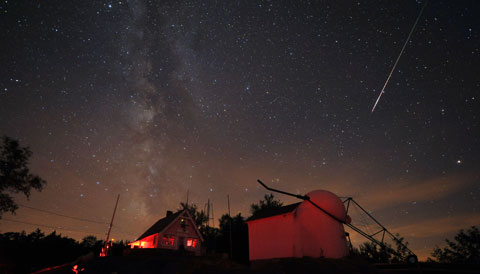
Dennis di Cicco
According to the International Meteor Organization, the shower's 2018 maximum should come between 20h UT on August 12th and 8h UT on the 13th. Fortunately, the midpoint of this range falls during the night of August 12-13 for North America. Moreover, the Moon will be new, so observing conditions are nearly perfect! Start watching on the evening of the 12th as soon as it's gotten dark and the radiant (near the Double Cluster in Perseus) clears the horizon. You might be rewarded with bright firefalls that skim Earth's atmosphere and create long, dramatic streaks in the sky.
These meteors are bits of debris shed by Comet 109P/Swift-Tuttle, which orbits the Sun every 130 years. Careful observers first realized that the Perseids are an annual event in the 1830s.
October 21: The Orionids
Here's another modest shower due to Halley's Comet. This year its peak on October 21st is during daylight in North America. Also, a nearly full Moon will create strong interference. But meteor experts predict that Orionid activity is on an upswing after some poor showings a few years ago. The shower’s radiant is located above Orion’s bright reddish star Betelgeuse.
November 5: The Southern Taurids
Lasting from mid-September to mid-November, this broad, weak display typically produces at most a dozen meteors per hour at its peak. But in 2005 skywatchers were treated to a "Taurid fireball swarm" dominated by bright, slow-moving fireballs from larger-than-average particles. A new Moon will offer no interference when the shower peaks, so be alert for some Taurid fireballs this year. The shower’s radiant is in western Taurus, along its border with Cetus.
November 18: The Leonids
The Leonid shower's parent comet, 55P/Tempel-Tuttle, tends to create narrow concentrated streams of debris that produced prodigious displays in the late 1990s, when it last swung close to the Sun. Since then the shower's activity has varied from year to year, usually offering little more than a trickle of shooting stars radiating from Leo’s Sickle. This year's peak (23h UT on November 17th) suggests looking late that night and especially after midnight on the 18th, by which time a waxing gibbous Moon will have set.
December 14: The Geminids
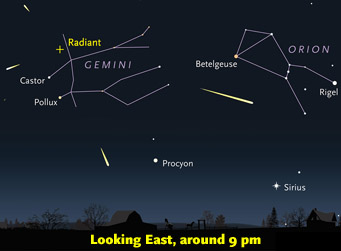
Sky & Telescope diagram
This end-of-the-calendar shower is usually the year’s best and most reliable, with upward of 100 meteors per hour radiating from a spot near the bright star Castor. The Geminid radiant is well up in the sky by 9 p.m. as seen from at mid-northern latitudes.
This year you'll have some evening interference from the nearly first-quarter Moon, but it will set before midnight. Besides, to see the Geminids at their best you'll want to be out later, in the hours before dawn, because this year the shower's brief peak is predicted for 12:30 UT — which is 7:30 a.m. on the East Coast and 4:30 a.m. on the West Coast.
Geminid meteors come from 3200 Phaethon, an asteroid discovered in 1983 that circles the Sun every 3.3 years. In fact, recent observations suggest that Phaethon might be a "rock comet" that sheds particles when its surface heats up to roughly 1,300°F (700°C) at each perihelion.
December 22: The Ursids
Although the Ursid shower delivers only a modest 10 meteors per hour under even the best conditions, it has the advantage of having a radiant near the bowl of the Little Dipper — so it's in view all night from northern latitudes. Unfortunately, this year its peak coincides with a full Moon, which will likewise be in the sky all night.
Keep tabs on meteor showers in 2018 and all the year's other celestial happenings with SkyWatch 2018, now also available as a digital edition.
 1
1
Comments
Glenn
December 30, 2017 at 8:52 pm
Last para before table of 2018 showers has 2017. Love the expression - a fat gibbous moon. Luna is the meteor obserbers nemesis! Clear skies and warm temps to 2018 observers... G
You must be logged in to post a comment.
You must be logged in to post a comment.